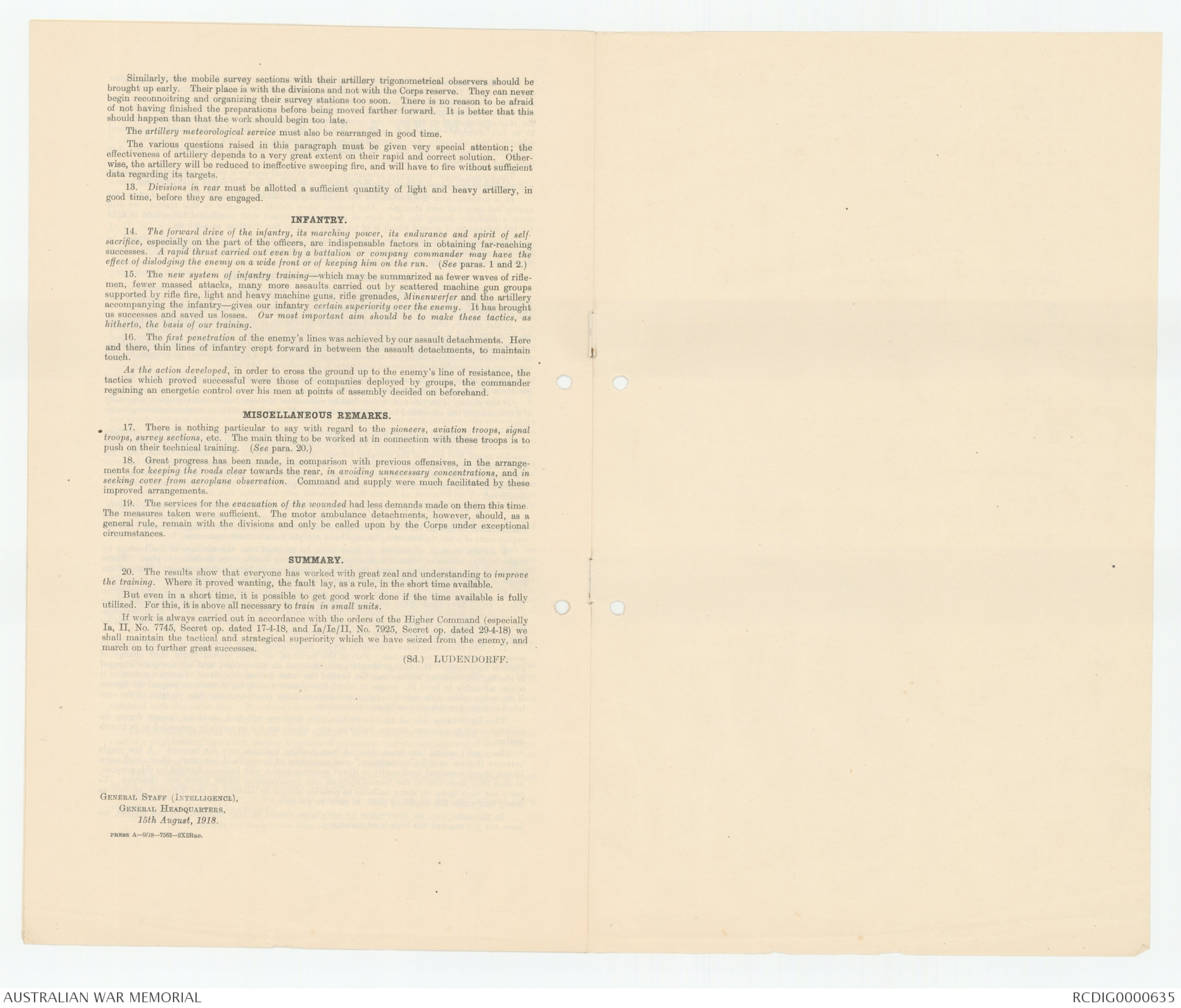General, Sir John Monash, Personal Files Book 20, 31 July - 15 August - 1918 - Part 18

Similarly, the mobile survey sections with the artillery trigonometrical observers should be
brought up early. Their place is with the divisions and not with the Corps reserve. They can never
begin reconnoitring and organizing their survey stations too soon. There is no reason to be afraid
of not having finished the preparations before being moved farther forward. It is better that this
should happen than that the work should begin too late.
The artillery meteorological service must also be rearranged in good time.
The various questions raised in this paragraph must be given very special attention; the
effectiveness of artillery depends to a very great extent on their rapid and correct solution. Otherwise,
the artillery will be reduced to ineffective sweeping fire, and will have to fire without sufficient
data regarding its targets.
13. Divisions in rear must be allotted a sufficient quantity of light and heavy artillery, in
good time, before they are engaged.
INFANTRY.
14. The forward drive of the infantry, its marching power, its endurance and spirit of self-
sacrifice, especially on the part of the officers, are indispensable factors in obtaining far-reaching
successes. A rapid thrust carried out even by a battalion or company commander may have the
effect of dislodging the enemy on a wide front or of keeping him on the run. (See paras. 1 and 2.)
15. The new system of infantry training - which may be summarized as fewer waves of riflemen,
fewer massed attacks, many more assaults carried out by scattered machine gun groups
supported by rifle fire, light and heavy machine guns, rifle grenades, Minenwerfer and the artillery
accompanying the infantry - gives our infantry certain superiority over the enemy. It has brought
us successes and saved us losses. Our most important aim should be to make these tactics, as
hitherto, the basis of our training.
16. The first penetration of the enemy's lines was achieved by our assault detachments. Here
and there, thin lines of infantry crept forward in between the assault detachments, to maintain
touch.
As the action developed, in order to cross the ground up to the enemy's line of resistance, the
tactics which proved successful were those of companies deployed by groups, the commander
regaining an energetic control over his men at points of assembly decided on beforehand.
MISCELLANEOUS REMARKS.
17. There is nothing particular to say with regard to the pioneers, aviation troops, signal
troops, survey sections, etc. The main thing to be worked at in connection with these troops is to
push on their technical training. (See para. 20.)
18. Great progress has been made, in comparison with previous offensives, in the arrangements
for keeping the roads clear towards the rear, in avoiding unnecessary concentrations, and in
seeking cover from aeroplane observation. Command and supply were much facilitated by these
improved arrangements.
19. The services for the evacuation of the wounded had less demands made on them this time.
The measures taken were sufficient. The motor ambulance detachments, however, should, as a
general rule, remain with the divisions and only be called upon by the Corps under exceptional
circumstances.
SUMMARY.
20. The results show that everyone has worked with great zeal and understanding to improve
the training. Where it proved wanting, the fault lay, as a rule, in the short time available.
But even in a short time, it is possible to get good work done if the time available is fully
utilized. For this, it is above all necessary to train in small units.
If work is always carried out in accordance with the orders of the Higher Command (especially
Ia, II, No. 7745, Secret op. dated 17-4-18, and Ia/Ic/II, No. 7925, Secret op. dated 29-4-18) we
shall maintain the tactical and strategical superiority which we have seized from the enemy, and
march on to further great successes.
(Sd.) LUDENDORFF
GENERAL STAFF (INTELLIGENCE),
GENERAL HEADQUARTERS,
15th August, 1918.
PRESS A--9/18--7563--2X2Rae.
 Lilly
LillyThis transcription item is now locked to you for editing. To release the lock either Save your changes or Cancel.
This lock will be automatically released after 60 minutes of inactivity.